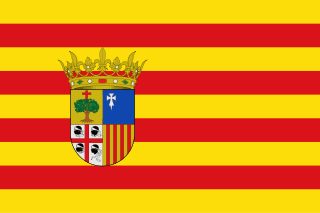
Aragon is an autonomous community in Spain, coextensive with the medieval Kingdom of Aragon. In northeastern Spain, the Aragonese autonomous community comprises three provinces : Huesca, Zaragoza, and Teruel. Its capital is Zaragoza. The current Statute of Autonomy declares Aragon a historic nationality of Spain.

Zaragoza, also known in English as Saragossa, is the capital city of the Zaragoza province and of the autonomous community of Aragon, Spain. It lies by the Ebro river and its tributaries, the Huerva and the Gállego, roughly in the center of both Aragon and the Ebro basin.

The Aragonese Party is a political party which advocates the interests of Aragon within Spain. The party was founded in 1978 under the name Aragonese Regionalist Party, but changed its name in 1990, keeping the initials PAR. The founders of PAR included Emilio Eiroa, who later served as the President of the Government of Aragon from 1991 to 1993.
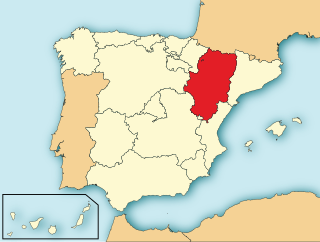
The Kingdom of Aragon was a medieval and early modern kingdom on the Iberian Peninsula, corresponding to the modern-day autonomous community of Aragon, in Spain. It should not be confused with the larger Crown of Aragon, that also included other territories — the Principality of Catalonia, the Kingdom of Valencia, the Kingdom of Majorca, and other possessions that are now part of France, Italy, and Greece — that were also under the rule of the King of Aragon, but were administered separately from the Kingdom of Aragon.

The Crown of Aragon was a composite monarchy, also nowadays referred to as a confederation of individual polities or kingdoms ruled by one king, originated by the dynastic union of the Kingdom of Aragon and the County of Barcelona and ended as a consequence of the Spanish War of Succession. At the height of its power in the 14th and 15th centuries, the Crown of Aragon was a thalassocracy controlling a large portion of present-day eastern Spain, parts of what is now southern France, and a Mediterranean "empire" which included the Balearic Islands, Sicily, Corsica, Sardinia, Malta, Southern Italy and parts of Greece.

The Chunta Aragonesista is a political party in Aragon (Spain), influenced by eco-socialism and pacifism. CHA defends a federal state, greater financial resources for Aragon, and the protection of the environment and hydrological resources of the Ebro Valley. It promotes the use of the Aragonese language.
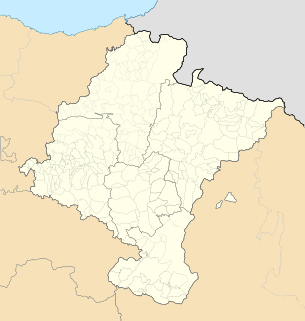
Petilla de Aragón is a town and municipality of the autonomous community of Navarra, northern Spain. The municipality itself is formed by two enclaves that are entirely surrounded by the neighboring autonomous community of Aragón.

Chía ; local pronunciation: [ˈtʃi.a]) is a municipality in Aragon in the province of Huesca, with an area of 25.95 km² and a population of 86 inhabitants (2018).

Alcañiz is a town and municipality of Teruel province in the autonomous community of Aragon, Spain. The town is located on the banks of the river Guadalope. Alcañiz is the unofficial capital of the Lower Aragon historical region. It lies some 113 km from Teruel, the provincial capital, and 92 km from Zaragoza, the capital of Aragon.
Duke of Gandía is a title of Spanish nobility that was first created in 1399 by Martin of Aragon and granted to Alfonso of Aragon and Foix. It has its origin in the lordship of Gandía created in 1323 by James II of Aragon. Later, having no direct descendants, the title passed from the House of Aragon to the House of Trastámara.

Abejuela is a municipality located in the province of Teruel, Aragon, Spain. According to the 2018 census (INE), the municipality has a population of 49 inhabitants. It is the southernmost town in Aragon.
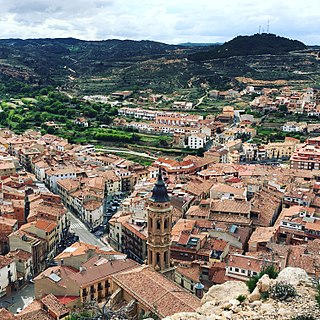
Alcorisa is a municipality in the province of Teruel, Aragon, Spain. According to the 2018 census the municipality has a population of 3,276 inhabitants.
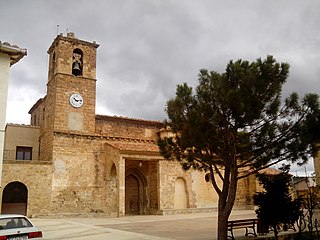
Bordón is a municipality located in the province of Teruel, Aragon, Spain. According to the 2010 census the municipality has a population of 141 inhabitants.

Layana is a municipality located in the province of Zaragoza, Aragon, Spain. According to the 2004 census (INE), the municipality has a population of 120 inhabitants.

Manchones is a municipality in the province of Zaragoza, Aragon, Spain. According to the Spanish Statistical Institute (INE), the municipality had a population of 123 inhabitants in 2010. The pueblo is in the comarca of Campo de Daroca, about 6 kilometres (3.7 mi) northwest of Daroca and just southeast of Murero in the Calatayud-Daroca depression. The Jiloca River passes to the west.

Ferdinand II was King of Aragon from 1479 to his death, and by his marriage King of Castile from 1474 to 1504 as Ferdinand V. He reigned over a dynastically unified Spain jointly with his wife Isabella I of Castile; together they are known as the Catholic Monarchs. Ferdinand is considered de facto the first king of Spain, being described as such during his own lifetime, although Castile and Aragon remained de jure two different kingdoms until the Nueva Planta decrees of 1707 to 1716.

Agüero is a village and a municipality located in the province of Huesca, Aragon, Spain. Its postal code is 22808. There are two churches in the village. The 12th-century Santiago church is the main attraction in the village proper. There is also a small hotel in the village.
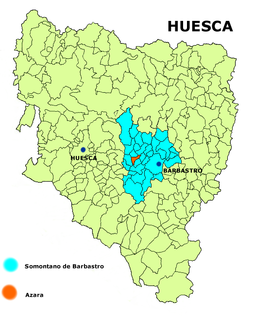
Azara is a municipality in the province of Huesca, Spain. In 2018, it had a population of 174 inhabitants. It is located in the middle of a valley named after Alferche, to the right of the La Clamor Canyon, surrounded by sandstone the highest among which is Peña de Santa Margarita, 40 km away from Huesca.

Ballobar is a municipality in the province of Huesca, Spain. As of 2010, it has a population of 981 inhabitants.

The 2019 Aragonese regional election was held on Sunday, 26 May 2019, to elect the 10th Cortes of the autonomous community of Aragon. All 67 seats in the Cortes were up for election. The election was held simultaneously with regional elections in eleven other autonomous communities and local elections all throughout Spain, as well as the 2019 European Parliament election.




















